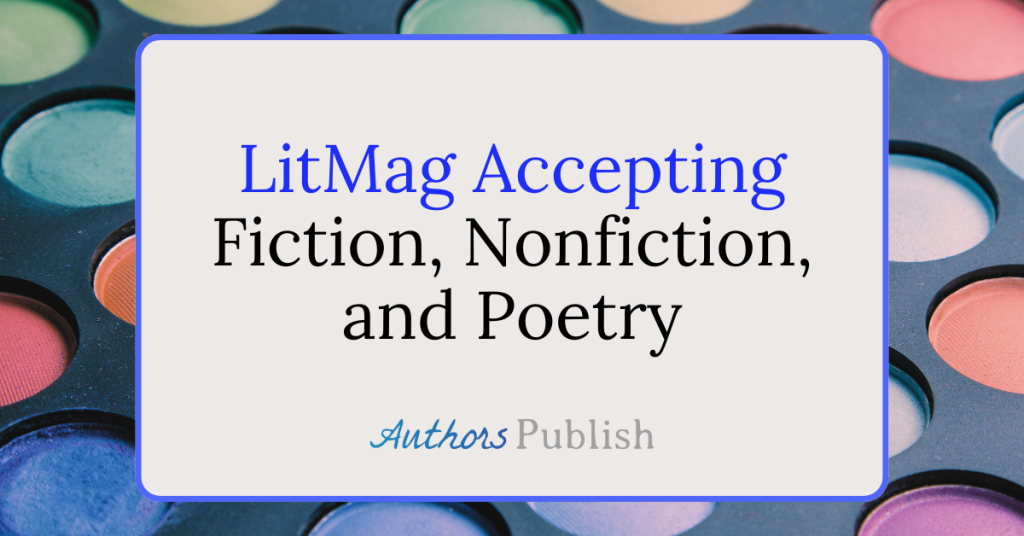I am starting off this article with a disclaimer. This article is not going to tell you what publishing trends are up and coming. I don’t know whether books about cats in Egypt are going to be the new board book trend or not. That isn’t my area of expertise, and it is not where my interest lies.
This article is all about the trends I have observed in the publishing industry – in terms of manuscript publishers, self-publishing, and literary journals – over the last year or so. The key word in the previous sentence is “I”. This article reflects my personal opinion, and what I have noticed. I write a new/updated version of this article every year.
Because I write a review of a manuscript publisher every week for Authors Publish, I spend a lot of time researching publishers and publishing. As a professional submitter for literary journals I submit to over 400 literary journals a year, which means I spend a lot of time exploring that world as well. I also receive hundreds of emails every year about publishing at support@authorspublish.com.
Below are all the trends that I have noticed developing over the last year. Some I hope will stop, others I hope will continue.
1. The euphoria of self-publishing is wearing off
This was true last year, and the year before that, but it is even more pronounced this year. When we used to publish an article about self-publishing, there would be a huge click-through rate. Not so much anymore. The self-published authors that we worked with have as a whole turned away from publishing entirely or have found traditional publishers.
We receive a lot fewer emails about self-publishing in general. Most of the emails that we receive are from self-published authors now seeking a traditional publisher for their book. As a side note, even fewer publishers than before are accepting previously self-published books.
Huge numbers of writers are still self-publishing, but there is far less enthusiasm about it.
2. Independent publishers are becoming more likely to be closed to unsolicited submissions
Independent publishers are less likely to be open to un-aganted submissions than they were last year. Particularly when it comes to fiction. However there is a silver lining. While these numbers are up, the increase is less than last year.
In 2017 about 10 independent publishers that I had previously reviewed closed their doors to unsolicited submissions, in 2018 less than five did. Hopefully this trend will continue to be on the decline.
3. There are fewer eBook-only publishers
It used to seem like every month a new digital publisher, usually focusing on romance, would arrive on the scene — sometimes with a lot of potential, sometimes not. This is no longer the case.
It has become rarer for a new digital-only publisher to open their doors. In part I think this is because the eBook market is more stable and established now, but also, potential publishers and editors are more aware of the challenges of entering an established market versus a new and rapidly changing one. I also think it is because eBook sales numbers have stabilized.
A number of eBook-only publishers have closed this year. Others that have focused on eBooks only are now publishing print versions as well. I think this is also a result of the market for eBooks stabilizing and becoming more consistent.
4. More literary journals are charging reading fees
Unfortunately this is a trend that just keeps growing. We at Authors Publish have been talking about this for a long time, and if you are interested in learning more about how reading fees work, this article is for you. I am not surprised this issue is continuing to be a large one. What I particularly dislike is the fact that more brand new journals are charging submission fees right from the beginning, even though they have no track record.
Also I have noticed that it is becoming more common to charge more than $3 to submit. The largest literary journal submission fee I have seen is for $25, which is preposterous.
5. More prestigious literary journals are charging reading fees
I’ve been monitoring the 100 most challenging markets on Duotrope for the last three years and each year more of the journals on that list, even those whose editors have spoken up against reading fees, have started charging fees. It is much more likely for a journal on that list to start charging fees, than one not on that list. So the journals that are receiving the most submissions and have the highest odds of rejecting a given submitter are much more likely to charge a fee to do so. Now around 50% of that list charges submitters. The closer a journal is to the top of that list, the more likely they are to charge.
6. More literary journals are having free submission options
Finally, some mostly-good news. Some literary journals that have added fees have lately made sure to have either fee-free periods or fee-free options. Some even have this neat option where, if you choose to pay a small fee to submit, they will give you feedback on your piece.
Unfortunately some literary journals are really bad at promoting the fee-free period, so you really have to keep your eyes peeled for it.
7. Presses have no time to send rejections
More presses are setting a deadline, sometimes a month, other times six, but always less than a year, where, if you have not heard from them, you should consider yourself rejected. This is becoming a more common policy for literary journals and magazines as well. I generally don’t mind this trend (a canned rejection letter is a canned rejection letter), but I do find it problematic when the press says they send out rejections, but they do not. If a press is upfront about this policy and offers a timeline, I think it works, although it is not ideal.
About 1 out of every 4 presses I reviewed this year explicitly stated that they do send out rejection letters, and that if you have not heard from them in a certain period of time, to assume rejection.
8. Print journals are becoming rarer and rarer
A lot of journals that were print are now electronic, partially or completely. New journals are much more likely to be electronic. If the publisher has extra money it goes towards Submittable or paying contributors, not into putting together a print issue. Even universities and established and respected literary journals are now switching to the online-only literary journal model. Electronic issues are more likely to have more readers. Additionally, it is a lot easier, not to mention cheaper, to run an electronic journals.
9. Publishers are consolidating
It is becoming common for larger independent presses to take over smaller independent presses. This was a trend last year, but it is even more prevalent this year.
10. More small manuscript presses are using Submittable
Submittable is a submission managing service that many literary journals have used for years. It is one of the factors that has made reading fees more common. For a while now literary journals that also publish books have used Submittable, but more recently presses that do not have a literary journal component are much more likely to use it. So far this has not had a direct correlation with an increase in reading fees for presses.
Are there any trends you have noticed in publishing that I have not mentioned here? Do you have any additional feedback? Please send me an email at support@authorspublish.com.
Bio: Emily Harstone is the pen name of an author whose work has been published internationally by a number of respected journals. She is a professional submissions adviser. You can follow her on Facebook here: https://www.facebook.com/emilyharstone/






